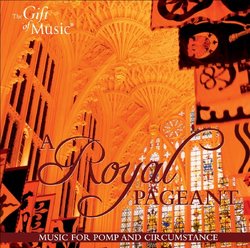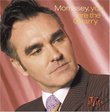| All Artists: New Zealand Symphony Orchestra;Stockholm Philharmonic Brass Ensemble;Royal Artillery Band;Choir of St John's College;Cambridge Title: A Royal Pageant Members Wishing: 0 Total Copies: 0 Label: The Gift of Music Original Release Date: 1/1/2009 Re-Release Date: 2/1/2009 Genre: Classical Style: Symphonies Number of Discs: 1 SwapaCD Credits: 1 UPC: 658592121223 |
Search - New Zealand Symphony Orchestra;Stockholm Philharmonic Brass Ensemble;Royal Artillery Band;Choir of St John's College;Cambridge :: A Royal Pageant
 | New Zealand Symphony Orchestra;Stockholm Philharmonic Brass Ensemble;Royal Artillery Band;Choir of St John's College;Cambridge A Royal Pageant Genre: Classical
A Royal Pageant — Music for Pomp and Circumstance Grand music for coronations, for ceremonial occasions, for matters of state and for formal dancing is brought together in this special album. 400 years of quintessentially B... more » |
Larger Image |
CD Details
Synopsis
Product Description
A Royal Pageant
Music for Pomp and Circumstance Grand music for coronations, for ceremonial occasions, for matters of state and for formal dancing is brought together in this special album. 400 years of quintessentially British music, from Matthew Locke to Eric Coates, centred around the peerless style of Sir Edward Elgar, whose 'Pomp and Circumstance' marches are familiar to us all. 'Pomp and Circumstance': for many this phrase perfectly expresses the Edwardian spirit of Great Britain before the First World War. And the music of Sir Edward Elgar is itself the essence of Edwardian: music for a period of empire and glory, when Britain ruled the waves and presided over the largest empire ever seen. Indeed, the 'Empire March' was composed for a celebration of empire at the Wembley Exhibition of 1924 and it exudes the confidence of the Edwardian age, despite its date of composition. The two 'Pomp and Circumstance' marches heard here date from before and after the First World War: No 4 from 1907 and No 5 from 1930, when the Empire itself was crumbling and coming to an end. You can't tell this from the music: both works retain a sense of importance, of grandeur and worth. All of Elgar's marches are brilliant pieces of music, superbly orchestrated and technically perfect. The 'Coronation March' was composed for the coronation of George V in 1911. It is far more than an occasional work and has the true grandeur of a composition influenced by all the greatest symphonic composers of Europe - Brahms, Dvorak and Wagner amongst them - that Elgar had studied carefully in his youth. Marches are perfect for a royal pageant, but brass music is too, and this album contains two superb suites of dances. Both feature English music from the seventeenth century. The first is suite created by Elgar Howarth using original music by, amongst others, Richard Dering, Anthony Holborne, Peter Philips and Thomas Tomkins. Peter Philips worked in England and Europe in the early years of the seventeenth century. Tomkins was an ardent royalist caught up in the terrifying events of the Commonwealth and the execution of Charles I. Matthew Locke worked for Charles II after the Restoration of the Monarchy. The 'Music for His Majesty's Sackbuts and Cornetts' was performed during the progress of the king from the Tower of London to Whitehall in April 1661 on the eve of his coronation: a true royal pageant! Our programme also contains a smattering of twentieth-century music. Eric Coates' suite 'The Three Elizabeths' was written in 1944. The music looks back to the golden age of Elizabeth I, and 'Halcyon Days', in particular, captures a sense of the heroism and confidence of that period: perfectly timed for a country still locked in the bitter Second World War. Coates, like Elgar, was a brilliant master of the orchestra, although, of course, his musical expression was more that of light music than of the very serious utterances of Elgar. This brilliance is retained in this performance by the Royal Artillery Band. Sir William Walton's 'Coronation Te Deum' was written for the coronation of Elizabeth II in 1953. Walton had a long connection with music for pageantry: his 'Crown Imperial' march had been written for the previous coronation, that of George VI in 1937 and he had also been commissioned to compose another march for the 1953 coronation, 'Orb and Sceptre'. Walton's 'Te Deum' is grand and spacious, well-suited to Westminster Abbey, where it was first performed on 2 June.
Music for Pomp and Circumstance Grand music for coronations, for ceremonial occasions, for matters of state and for formal dancing is brought together in this special album. 400 years of quintessentially British music, from Matthew Locke to Eric Coates, centred around the peerless style of Sir Edward Elgar, whose 'Pomp and Circumstance' marches are familiar to us all. 'Pomp and Circumstance': for many this phrase perfectly expresses the Edwardian spirit of Great Britain before the First World War. And the music of Sir Edward Elgar is itself the essence of Edwardian: music for a period of empire and glory, when Britain ruled the waves and presided over the largest empire ever seen. Indeed, the 'Empire March' was composed for a celebration of empire at the Wembley Exhibition of 1924 and it exudes the confidence of the Edwardian age, despite its date of composition. The two 'Pomp and Circumstance' marches heard here date from before and after the First World War: No 4 from 1907 and No 5 from 1930, when the Empire itself was crumbling and coming to an end. You can't tell this from the music: both works retain a sense of importance, of grandeur and worth. All of Elgar's marches are brilliant pieces of music, superbly orchestrated and technically perfect. The 'Coronation March' was composed for the coronation of George V in 1911. It is far more than an occasional work and has the true grandeur of a composition influenced by all the greatest symphonic composers of Europe - Brahms, Dvorak and Wagner amongst them - that Elgar had studied carefully in his youth. Marches are perfect for a royal pageant, but brass music is too, and this album contains two superb suites of dances. Both feature English music from the seventeenth century. The first is suite created by Elgar Howarth using original music by, amongst others, Richard Dering, Anthony Holborne, Peter Philips and Thomas Tomkins. Peter Philips worked in England and Europe in the early years of the seventeenth century. Tomkins was an ardent royalist caught up in the terrifying events of the Commonwealth and the execution of Charles I. Matthew Locke worked for Charles II after the Restoration of the Monarchy. The 'Music for His Majesty's Sackbuts and Cornetts' was performed during the progress of the king from the Tower of London to Whitehall in April 1661 on the eve of his coronation: a true royal pageant! Our programme also contains a smattering of twentieth-century music. Eric Coates' suite 'The Three Elizabeths' was written in 1944. The music looks back to the golden age of Elizabeth I, and 'Halcyon Days', in particular, captures a sense of the heroism and confidence of that period: perfectly timed for a country still locked in the bitter Second World War. Coates, like Elgar, was a brilliant master of the orchestra, although, of course, his musical expression was more that of light music than of the very serious utterances of Elgar. This brilliance is retained in this performance by the Royal Artillery Band. Sir William Walton's 'Coronation Te Deum' was written for the coronation of Elizabeth II in 1953. Walton had a long connection with music for pageantry: his 'Crown Imperial' march had been written for the previous coronation, that of George VI in 1937 and he had also been commissioned to compose another march for the 1953 coronation, 'Orb and Sceptre'. Walton's 'Te Deum' is grand and spacious, well-suited to Westminster Abbey, where it was first performed on 2 June.
Similar CDs
| Rico Monaco & Sol Sons Ciao Bella Signorina Genres: Jazz, Pop, R&B, Latin Music Label: Ricmon 2-003 | |

 Track Listings (8) - Disc #1
Track Listings (8) - Disc #1

